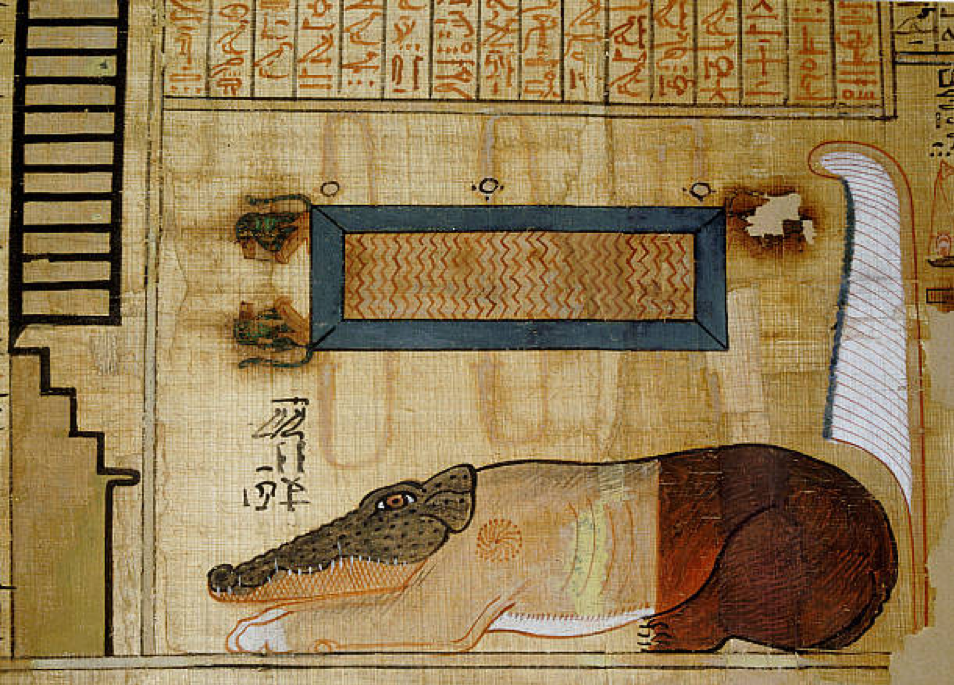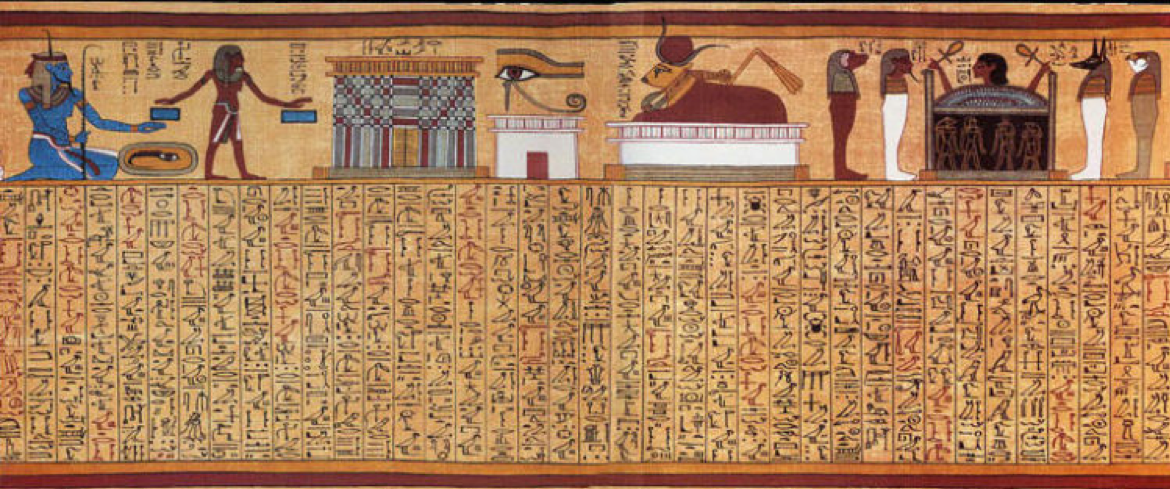When the art of ancient Egypt is described, the following is said: it was very symbolic and stylized; extremely conservative, because it changed very little in more than 3000 years; much of the art that has survived comes from tombs and monuments, so the most touched issue is the life after death and preserve the knowledge of the past.
The Egyptians believed firmly in life after death. They were buried, accompanied by a series of magic formulas to travel the Hereafter. These magic formulas were found in several “books” that detailed them. According to the time, they were the “Books of the Pyramids” because these formulas were written on the walls initially, then the “Books of the Sarcophagi” and finally the “Book of the Dead”. Without them, the deceased could suffer a second death that would mean their definitive annihilation.

Book of the Dead of Nebqed. The Swallower of the Dead monster
They believed that the person who died had to make a long underground journey from west to east, like the Sun, Ra for them, in which they would face terrible monsters that would prevent their rebirth. Then they would arrive at a labyrinth with twenty-one doors, where he would recite formulas in each one of the doors and finally he would be in front of a tribunal formed by 42 judges, presided over by Osiris where in which his life is evaluated: the “negative confession” was made “, Citing all the wrong actions he had not committed; and then his heart was weighed, on a scale compared to the pen of Maat representing justice, if the heart and pen were in balance, the deceased was saved. If the deceased was not considered worthy, he was condemned to all kinds of punishments such as perpetual hunger and thirst, being tortured, among others. If the deceased was saved, he would live in the Field of the Cañas or Juncos, where he had to “plow and mow, eat and drink, and perform all the things that are done on earth.” It means, they had to work.
But there was cheating, they could count on an army of servants, that is, the ushebtis. The ushebtis were small statues that became servants. The richest characters were buried with 365 ushebtis to have a servant for each day of the year. The ushebtis could be simple or very sophisticated, the important thing was that they had a magical inscription that made them servants in the Hereafter.
Ushebtis
At first, only the pharaoh had these magic formulas and therefore right to life in the Hereafter, but later, they would also appear in the tombs of the nobles and finally in the grave of some servants.
Each of the paintings, sculptures or writings in a tomb have a special meaning and are part of a whole. The life of the past of the deceased, a matter of great importance, because if he made a mistake in some step, it would disappear forever. Therefore, the artisans in charge of it had at the same time a very important work for Egyptian society and a lot of responsibility. From this two ideas can be detached: they were relevant people and on the other hand, they could not change much the formulas of their works because the Gods could be disturbed. You had to follow a very specific and very clear path, that is, you have to be a convert.
 Book of the Dead
Book of the Dead
As it was an illustrated album, you cannot interpret the hieroglyphic writings, the statuettes and the paintings or engravings, even the mummy with its bandages, and the vases that had the organs extracted from the mummified body must carry. Interpreted as a whole. The same objects change their meaning depending on the inscriptions associated with them. All art is highly functional and at the same time very spiritual and personal. And I insist it must be exact. Art was ruled by the religion that was dominated by Pharaoh and priestly castes. It was not free, but it had to fulfill a religious mission in the case of tombs and propaganda in the case of monumental art.
Interestingly, the public of the funeral art are the same deaths and the Gods in those who believe. That, as he commented previously, does not diminish him, rather he gives it to him. Pharaoh and his nobles were in charge of hiring the best artisans to help them reach their life in the afterlife.
In addition to the “Book of the Dead”, used in the time of the new empire, there were other books that provided magic formulas, the “Book of the Sarcophagi”, or the “Book of the Two Ways”, among others. There were other books such as the “Book of the Amduat” that tells us about the night journey of the god Re and his retinue throughout the 12 hours that night by the Duat, the kingdom of the underworld ruled by Osiris. Of this last the book there are two versions, the extended or the reduced. The reduced only includes texts, the extended is accompanied by children book illustrations.

Amduat
In this image of the Amduat in papyrus, one can clearly distinguish the quality of the scribes who illustrated and wrote it. The grace and delicacy of the line sare undeniable. Although clearly schematic, it makes use of the expressiveness of the line to shape the figures.
The skills of the artists in all cases is undoubted. They were respected and highly developed professions in every way. They were fundamental.
Seeing any of the religious books of the Egyptians makes you want to take out parchment and ink and get to work. In the Egyptian Museum of Turin you can enjoy the “Book of the Dead”, it is a marvel.